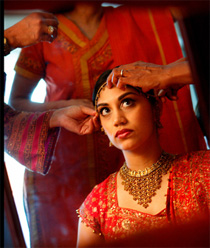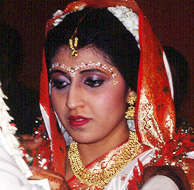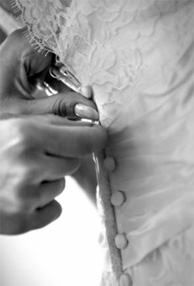
 Go Back
Go Back

The Lineage of Women
By Cornelia Powell

"A woman is the full circle of life. Within her is the power to
create, Nurture, and transform."
~ Diane Mariechild, 20th century American Psychotherapist
 In
villages and tribes all over the world, women sing the songs of their
mothers and grandmothers as they prepare a bride for her wedding
ceremony:1 applying henna to her hands and feet;
combing and arranging her hair; perfuming her body with herbs; draping
her in shimmering jewels; or meticulously dressing her in the finest
garments available for the family. These interactions carry on ancient
rituals in the lineage of women, and they provide emotional support for
the woman next in line to join this formidable sisterhood of brides. The
old-world wedding traditions define a community and become a source of
consistency in a rapidly changing world.
In
villages and tribes all over the world, women sing the songs of their
mothers and grandmothers as they prepare a bride for her wedding
ceremony:1 applying henna to her hands and feet;
combing and arranging her hair; perfuming her body with herbs; draping
her in shimmering jewels; or meticulously dressing her in the finest
garments available for the family. These interactions carry on ancient
rituals in the lineage of women, and they provide emotional support for
the woman next in line to join this formidable sisterhood of brides. The
old-world wedding traditions define a community and become a source of
consistency in a rapidly changing world.
In all parts of the world, weddings offer a creative stage for families
and communities to come together and tell the story of their heritage.
The portrayal of each inherited ritual reveals something
precious—connecting past, present and future. Women play the leading
role in this essential pageantry; not just with their talents, but with
their passion and energy—which gives these rites of passage the power
and essence of life itself. Women have learned to use this life force to
affect their world in many subtle as well as profound ways.
 According to philosopher
Joseph Campbell, the main theme in ritual is the linking of an
individual to something larger than their own physical body—something
outside of what one knows life to be.2 The
rituals from indigenous cultures prepare a bride for her new role in
life. They are a connection to this type of transformation and are
skills women learn from their rich ancestry. Arranging an intricate
hairstyle or draping a bride’s silk sari as it has been done for
hundreds, perhaps thousands of years are all rituals that become a
reverie for both giver and receiver, moving one outside of the physical
into a lighter, more spiritual world. In this prayerful mode, a woman is
not only creating exquisite artwork, she is putting her love, intent
and energy into the spirit of the process, encouraging and blessing
another woman’s life—continuing the vibrant lineage of women.
According to philosopher
Joseph Campbell, the main theme in ritual is the linking of an
individual to something larger than their own physical body—something
outside of what one knows life to be.2 The
rituals from indigenous cultures prepare a bride for her new role in
life. They are a connection to this type of transformation and are
skills women learn from their rich ancestry. Arranging an intricate
hairstyle or draping a bride’s silk sari as it has been done for
hundreds, perhaps thousands of years are all rituals that become a
reverie for both giver and receiver, moving one outside of the physical
into a lighter, more spiritual world. In this prayerful mode, a woman is
not only creating exquisite artwork, she is putting her love, intent
and energy into the spirit of the process, encouraging and blessing
another woman’s life—continuing the vibrant lineage of women.
1. Cynthia Becker, “Gender, Identity and Moroccan Weddings: The
Adornment of the Ait Khabbash Berber Bride and Groom,” Wedding Dress
Across Cultures, (Oxford, England: Berg, 2003), 195.
2. Joseph Campbell, The Power of Myth, (Doubleday, 1988), 125
© 2004 Cornelia Powell, all right reserved.
[This is an excerpt from Cornelia's book-in-progress, Weddings of
Grace: The Bride You Want to Be, The Woman You Become—the
inspiration for this online magazine.]
As Featured on
Weddings of Grace

